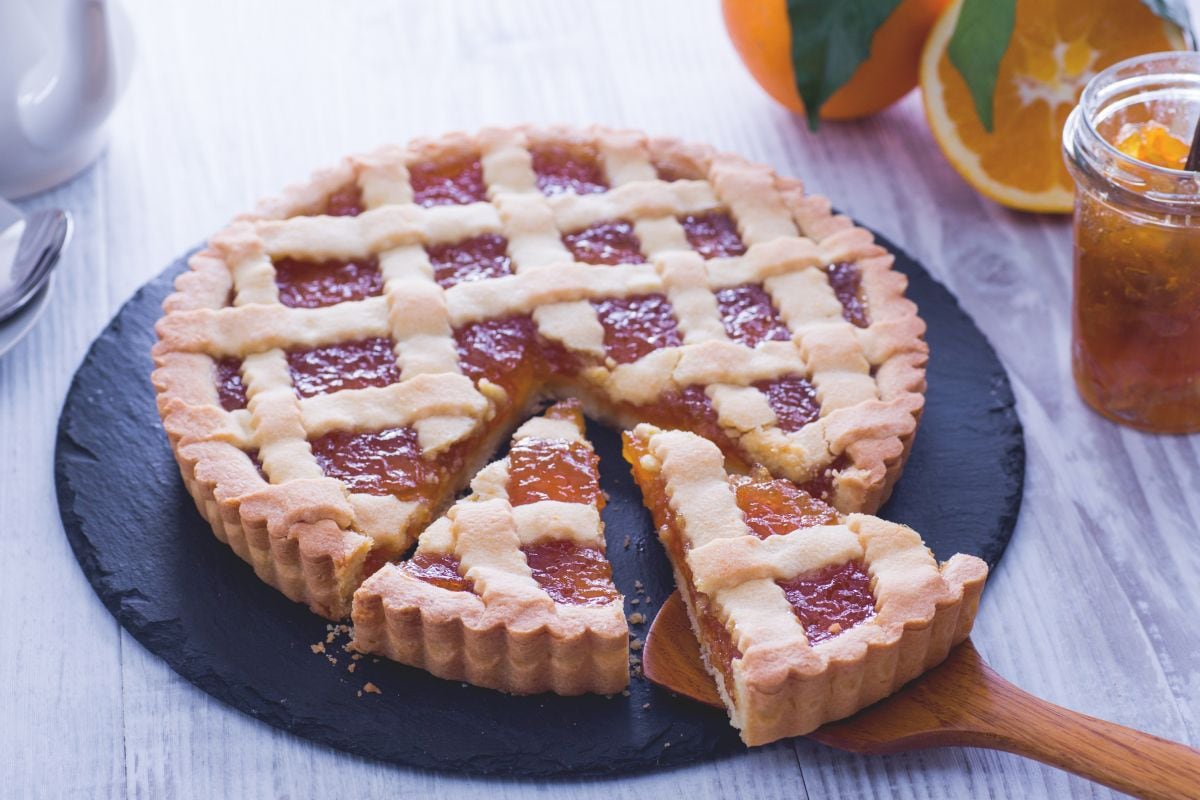Caramelized Orange Tart
- Easy
- 1 h 25 min
- Kcal 597

When it comes to classic Italian desserts, the orange crostata is a real winner. I mean, this is a treat for anyone who craves something sweet but also tangy. At its heart, you’ve got this buttery 'pasta frolla' crust—so tender and crumbly—it just pairs perfectly with bright orange marmalade. And listen, it's not uncommon to find this citrus crostata gracing breakfast tables or being enjoyed as a snack all over Italy. Often, it is made with homemade jam. Really, while some might go for apricot, the orange marmalade version is super special, especially with those bits of zest adding that extra fragrant touch.
Even if you’re not into sweets, this dessert's not-too-sugary profile and melt-in-your-mouth crust might just win you over. Seriously, in different regions of Italy, people get creative with their crostata, sometimes using blood oranges for a unique spin on the orange crostata. The beauty of this dish? It's in its simplicity. Whether you’re hand-mixing the dough or using a mixer for convenience, you get that golden, rustic look.
The lattice pattern on top lets the jam bubble up—so lovely—making it a Italian tart that pairs perfectly with morning coffee or as an after-dinner delight. Many rustic crostata recipes use leftover summer jams, adding a homemade and special touch. And the combo of moist jam with crisp pastry? Can't go wrong. Especially when you’re yearning for that cozy Italian kitchen vibe. It’s a no-fuss dessert, but each bite has that really, really good mix of crispy and sweet flavors. Once you've tried it, you'll probably be planning to make it again soon. Pretty much a dish that truly captures the essence of Italian home cooking. Bringing a little piece of Italy right into your home—amazing.
You might also like:

To prepare the orange tart, first, make the shortcrust pastry: place the flour and cold cubed butter in the mixer 1, blend everything in short bursts to avoid heating the dough too much, until you get a sandy mixture 2, then stop the blades and flavor it with orange zest 3,

add the powdered sugar 4 and the lightly beaten eggs 5. Turn on the mixer to mix the ingredients and obtain a homogeneous dough 6.

Transfer the dough to a work surface 7 and work it quickly, just enough time to compact it and form a dough ball. Wrap the dough ball with plastic wrap 8 and let it firm up in the fridge for 1 hour. After the specified time, take the dough ball, roll it out with a rolling pin on the work surface 9

roll out the dough to a thickness of about 1/4 inch 10. Roll the rolled-out dough onto the rolling pin 11 and gently unroll it over a fluted tart pan with a diameter of 9.5 inches 12.

With your fingers, press the dough into the edges to make it adhere well to the pan 13. At this point, run the rolling pin over the edge of the pan to trim away excess dough evenly and neatly 14. Prick the bottom of the tart with a fork to prevent air bubbles from forming during baking 15.

Fill the tart with marmalade, spreading it evenly with the back of a spoon 16. Take the leftover dough, roll it out to a thickness of 1/4 inch. Cut strips of dough with a fluted wheel 17. Now apply the strips of dough by intersecting them: attach 5 strips of dough to the edge of the tart starting with the first 18, spacing the others evenly.

Place the first, the middle, and the last one on the surface as shown in the photo 19, alternating them with those placed in the opposite direction; then lay one transversely 20 and also lay the other two vertical strips that you had left folded 21.

Lift again, this time the first strip, the third, and the last one 22 and lay another one horizontally 23; proceed by folding the vertical strips over the tart and continue with this technique to finish all the strips 24.

Once the entire tart is covered, press the ends firmly with your fingers on the edge 25. Once ready 26, bake the orange tart in a static oven on the lower shelf at 340°F for 50 minutes. Once baking is complete, remove the orange tart from the oven, let it cool 27 before unmolding it.